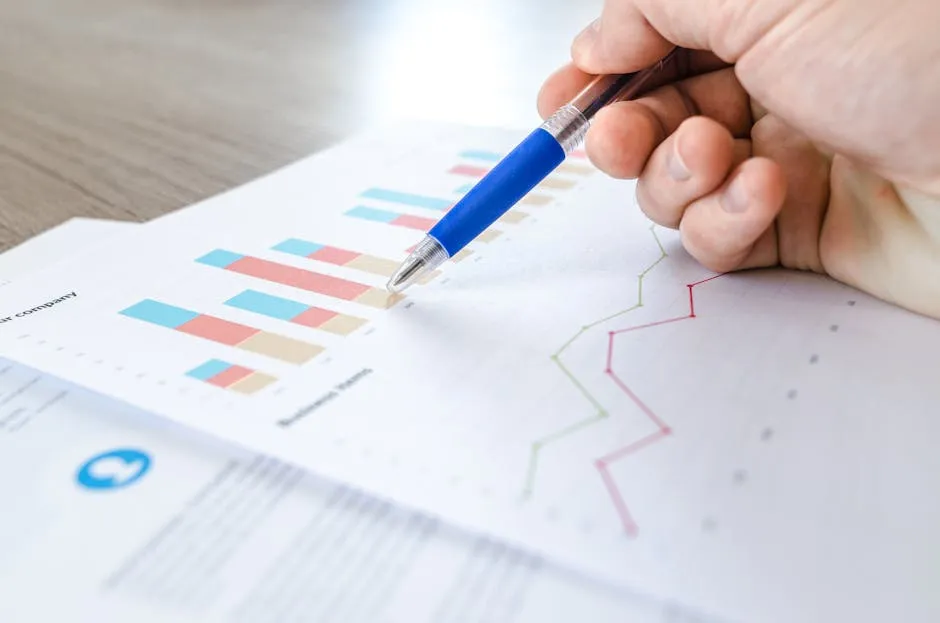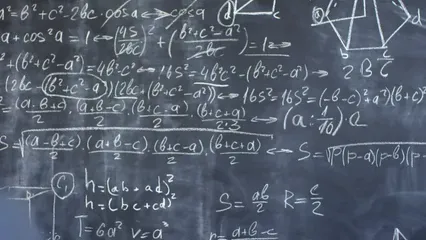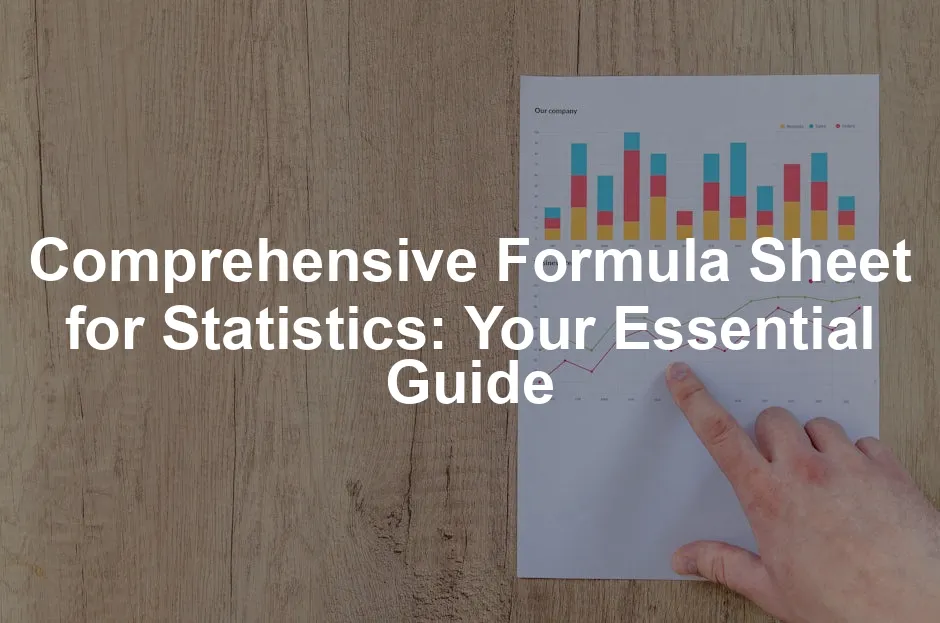Introduction
Statistics is the science of collecting, analyzing, and interpreting data. This mathematical tool helps make sense of the chaotic world around us. Whether you’re trying to predict the weather or analyze consumer behavior, statistics provides the backbone for informed decision-making.
In various fields like healthcare, finance, and social sciences, statistics is crucial. It aids researchers and professionals in drawing conclusions based on data, uncovering trends, and making predictions. So, if you’ve ever pondered why your favorite ice cream shop always runs out of mint chocolate chip, statistics could have the answer!
This article aims to create a comprehensive formula sheet for statistics. Think of it as your trusty sidekick during study sessions or data analysis. This guide simplifies complex concepts, offering quick references for students and professionals alike. Whether you’re preparing for exams or tackling real-world data challenges, having essential formulas at your fingertips makes life infinitely easier.
To get started on your statistical journey, consider picking up a copy of Statistics for Dummies. This book breaks down complex concepts into digestible bites, ensuring you won’t feel overwhelmed. Plus, it’s perfect for anyone looking to brush up on their statistical skills!
Understanding statistical formulas unlocks the door to academic success and data literacy. It empowers you to analyze data effectively, leading to informed decisions in your personal and professional life. So, whether you’re crunching numbers for a school project or conducting in-depth research, this formula sheet will serve as your secret weapon. With it, you can approach statistics with confidence and clarity, transforming what was once daunting into a manageable task.

For a deeper understanding of statistical learning, consider reading an introduction to statistical learning with Python.
Understanding Statistics
What is Statistics?
Statistics is a branch of mathematics focused on collecting, analyzing, interpreting, presenting, and organizing data. It’s not just about crunching numbers; it’s about deriving insights that inform decisions. In our fast-paced world, making sense of vast amounts of information is essential. Statistics helps us summarize data and transform it into actionable knowledge.
From scientific research to market analysis, statistics plays a vital role in shaping conclusions. For instance, businesses utilize it to gauge customer satisfaction, while healthcare professionals rely on it to track disease outbreaks. With its widespread applications, understanding statistics is crucial for navigating today’s data-driven landscape.
Speaking of which, if you’re looking to dive deeper into the world of data, consider grabbing The Art of Statistics: Learning from Data. It’s a fantastic resource that blends theory with practical examples, making it a must-read for aspiring statisticians.
Types of Statistics
Statistics can be broadly divided into two main categories: descriptive and inferential statistics.
- Descriptive Statistics: This type summarizes and organizes data, making it easier to understand. Think of it as the neat and tidy part of statistics. Descriptive statistics provide essential insights through measures such as mean, median, and mode. For example, if you have a dataset of exam scores, descriptive statistics can help you find the average score or identify the most common score among students. For a comprehensive guide on this topic, check descriptive statistics in manufacturing plant.
- Inferential Statistics: This type goes a step further by using a sample of data to make inferences about a larger population. It’s like taking a small bite of cake to determine if the whole cake is delicious. Inferential statistics help us predict outcomes and test hypotheses. For instance, if a company surveys 100 customers about their satisfaction, they can infer trends about their entire customer base based on that sample. To learn more about the challenges in this area, you might explore the problem with inferential statistics.
In summary, both types of statistics are essential for understanding data and making informed decisions. By mastering these concepts, you’ll be well-equipped to tackle various challenges in your academic and professional journey.

Key Statistical Concepts
Understanding key statistical concepts is crucial for anyone looking to make sense of data. This section highlights the primary measures of central tendency, dispersion, and shape, providing essential formulas and insights for your statistics toolkit.
Measure of Central Tendency
When analyzing data, knowing the center helps. Measures of central tendency—mean, median, and mode—are the three amigos of statistics. They give you a snapshot of where your data tends to cluster.
- Mean: The mean, or average, is calculated by adding all values together and dividing by the number of values. It’s like sharing a pizza equally among friends. If you’re trying to find the mean of exam scores, simply sum those scores and divide by the number of students. For a detailed explanation of what it means to be identically distributed, refer to what does mean identically distributed in statistics.
- Median: The median represents the middle value when data is sorted. It’s your go-to when you want a value less affected by outliers. For an odd number of observations, it’s the middle one. For an even number, it’s the average of the two middle values. You can gain insights into median salary trends, such as those in Poland for 2024, by checking statistics Poland median salary 2024.
- Mode: The mode is the value that appears most frequently in your dataset. You can have one mode (unimodal), more than one mode (bimodal or multimodal), or no mode at all if all values are unique. For a comprehensive understanding of mode and its applications, consider reading about statsmodels residuals statistics.
If you’re serious about mastering statistics, you might want to check out Excel Statistics: A Quick Guide. This guide will help you leverage Excel to perform complex statistical analyses without pulling your hair out!

Measure of Dispersion
While central tendency shows where data points tend to gather, measures of dispersion illustrate how spread out the data is. This helps you understand the variability in your dataset.
- Range: The range indicates the difference between the largest and smallest values in a dataset. It’s a simple way to gauge spread but can be heavily influenced by outliers.
- Variance: Variance measures how far a set of numbers is spread out from their mean. There are two types: sample variance and population variance.
- Standard Deviation: The standard deviation is the square root of variance. It provides a sense of how much individual data points differ from the mean.
Measure of Shape
The shape of your data distribution is essential for understanding its characteristics. Two primary measures of shape are skewness and kurtosis.
- Skewness: Skewness describes the asymmetry of the distribution. A positive skew indicates a longer right tail, meaning the mean is greater than the median. A negative skew means a longer left tail, with the mean less than the median. If the skewness is zero, the distribution is symmetrical.
- Kurtosis: Kurtosis measures the “tailedness” of the distribution. It indicates how much of the data is in the tails compared to the center.
Measure of Relationship
Understanding the relationships between variables is a cornerstone of statistics. Two key concepts in this realm are covariance and correlation. Let’s break them down.
- Covariance: Covariance is a statistical measure that indicates the extent to which two variables change together. If both variables tend to increase together, the covariance is positive. Conversely, if one variable increases while the other decreases, the covariance is negative.
- Correlation: This concept measures the strength and direction of the linear relationship between two variables. Unlike covariance, correlation is standardized, making it easier to interpret.

Probability Theory
Basic Concepts
Let’s kick off with the basics of probability. Probability is the branch of mathematics that deals with the likelihood of events occurring. It’s a way to quantify uncertainty. The probability of an event ranges from 0 (impossible) to 1 (certain). For instance, the probability of flipping a coin and it landing on heads is 0.5.
- Theoretical Probability: This is based on the reasoning behind probability. It’s calculated by dividing the number of favorable outcomes by the total number of possible outcomes.
- Experimental Probability: This type is based on actual experiments or trials. It’s calculated by taking the number of times an event occurs, divided by the total number of trials.
- Subjective Probability: This is based on personal judgment or experience rather than exact calculations.
If you’re looking to delve deeper into probability, check out Probability Theory: The Logic of Science. This book provides a solid foundation for understanding the principles that underpin probability.

Probability Formulas
Now, let’s explore some key probability formulas.
- Joint Probability: Refers to the probability of two events occurring together.
- Union and Intersection of Events: The union refers to the probability of at least one of the events occurring, while the intersection refers to the probability that both events happen.
- Conditional Probability: This describes the probability of an event occurring given that another event has already happened.

Hypothesis Testing
Introduction to Hypothesis Testing
Hypothesis testing is a cornerstone of inferential statistics. It provides a method for making decisions about population parameters based on sample data. By testing hypotheses, researchers can draw conclusions and make predictions about a larger population.
Key Concepts
At its core, hypothesis testing involves formulating two competing statements: the null hypothesis (H₀) and the alternative hypothesis (H₁). The null hypothesis typically represents the status quo or a statement of no effect, while the alternative hypothesis reflects a new effect or difference.
- Null Hypothesis (H₀): It posits that there is no significant difference or effect.
- Alternative Hypothesis (H₁): It suggests that there is a significant difference or effect.
- Type I Error (α): This occurs when the null hypothesis is incorrectly rejected.
- Type II Error (β): This happens when the null hypothesis is not rejected when it is false.
- P-value: The P-value is the probability of observing results at least as extreme as those in your sample, assuming the null hypothesis is true.
To further enhance your understanding, consider reading Hypothesis Testing: A Step-by-Step Guide. This resource will walk you through the intricacies of hypothesis testing, making it easier to grasp.

Common Statistical Tests
When diving into statistics, understanding common statistical tests is essential. These tests help you analyze data, draw conclusions, and make informed decisions.
- Z-test: A statistical test used to determine if there’s a significant difference between sample and population means or between two sample means.
- T-test: Another essential statistical test used to compare means, particularly useful when dealing with small sample sizes or when the population variance is unknown.
- ANOVA: Used when comparing three or more group means to see if at least one differs significantly.

FAQs
What are the most important statistical formulas for beginners?
1. Mean (average): \( \bar{x} = \frac{\sum x}{n} \) This formula calculates the average of a data set. 2. Median: The middle value when data is sorted. If N is odd, it’s the \((N + 1)/2\)th observation. If even, average the two middle values. 3. Mode: The value that appears most frequently in the dataset. 4. Standard Deviation: \( s = \sqrt{\frac{\sum (x_i – \bar{x})^2}{n – 1}} \) This measures the spread of data around the mean. 5. Probability: \( P = \frac{\text{Favorable outcomes}}{\text{Total possible outcomes}} \) This formula helps calculate the likelihood of an event.
How can I effectively use a formula sheet for statistics?
Using a formula sheet efficiently requires practice. Here are some tips: 1. Familiarize Yourself: Spend time understanding each formula and when to apply it. 2. Practice Problems: Solve a variety of statistical problems using the formulas. 3. Group Study: Discuss formulas and their applications with peers to reinforce understanding. 4. Real-World Applications: Try to connect formulas to real-life situations to see their practical use.
Are there any resources for further learning in statistics?
Absolutely! Here are some great resources: 1. Books: Look for “Statistics for Dummies” or “The Art of Statistics” by David Spiegelhalter for approachable introductions. 2. Online Courses: Platforms like Coursera and edX offer courses in statistics, including those tailored for beginners. 3. Websites: Websites like Khan Academy and Stat Trek provide free tutorials and exercises to reinforce your knowledge.
Please let us know what you think about our content by leaving a comment down below!
Thank you for reading till here 🙂 And if you’re looking for some tools to help you with your studies, consider grabbing a Graphing Calculator TI-84 Plus or a Scientific Calculator Casio fx-991EX. Both are fantastic for tackling those tricky calculations!
All images from Pexels




